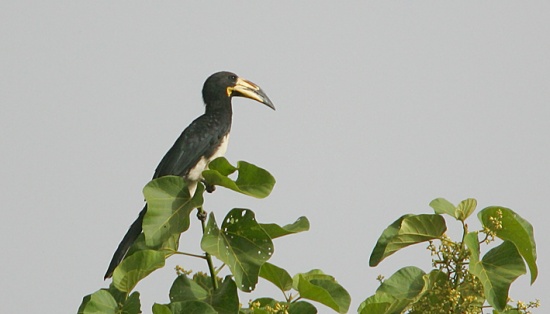(User template) |
(Attempt to disguise copied text. Distribution & Taxonomy expanded. Referenced) |
||
| Line 1: | Line 1: | ||
[[Image:African_Pied_Hornbill.jpg|thumb|550px|right|Photo by {{user|Steve+G|Steve G}}]] | [[Image:African_Pied_Hornbill.jpg|thumb|550px|right|Photo by {{user|Steve+G|Steve G}}]] | ||
;[[:Category:Tockus|Tockus]] fasciatus | ;[[:Category:Tockus|Tockus]] fasciatus | ||
| − | |||
| − | |||
==Identification== | ==Identification== | ||
| − | 54cm | + | 54cm<br /> |
| − | + | *Mainly black | |
| + | *White belly and tail tip | ||
| + | *Long curved black and yellow bill | ||
| + | *Medium-sized casque<br /> | ||
| + | Sexes are similar, but the '''female''' has a smaller casque<br /> | ||
| + | '''Immature birds''' are duller, have a smaller bill, and no casque. | ||
==Distribution== | ==Distribution== | ||
| − | Equatorial [[Africa]] | + | Equatorial [[Africa]]:<br /> |
| − | + | '''Western Africa''': [[Senegambia]], [[Senegal]], The [[Gambia]], [[Guinea-Bissau]], [[Guinea]], [[Sierra Leone]], [[Liberia]], [[Ivory Coast]], [[Ghana]], [[Togo]], [[Benin]], [[Nigeria]], [[Cameroon]], [[Central African Republic]], [[Equatorial Guinea]], [[Gabon]], [[Congo]], [[Angola]]<br /> | |
| + | '''Eastern Africa''': [[Sudan]], [[Kenya]], [[Uganda]], [[Tanzania]] | ||
==Taxonomy== | ==Taxonomy== | ||
| − | + | ====Subspecies<sup>[[#References|[1]]]</sup>==== | |
| − | + | *''T. f. semifasciatus'': | |
| + | :*[[Senegambia]] to just east of Niger River | ||
| + | *''T. f. fasciatus'': | ||
| + | :*[[Nigeria]] (east of Niger River) to [[Angola]], [[Zaire]] and [[Uganda]] | ||
==Habitat== | ==Habitat== | ||
Forests. | Forests. | ||
==Behaviour== | ==Behaviour== | ||
| − | + | ====Breeding==== | |
| − | + | The nest is in a tree hole and 4 white eggs are laid. During incubation, the entrance is blocked leaving a small gap to enable the male to pass food through to the female and chicks. Eventually the female breaks out and rebuilds the wall. Both adults then feed the chicks. | |
| + | ====Diet==== | ||
The diet includes fruit and insects. | The diet includes fruit and insects. | ||
| − | |||
====Vocalisation==== | ====Vocalisation==== | ||
The call is a whistling ''pii-pii-pii-pii-''. | The call is a whistling ''pii-pii-pii-pii-''. | ||
| − | + | ==References== | |
| + | #{{Ref-Clements6thDec08}}#Avibase | ||
| + | #Avibase | ||
==External Links== | ==External Links== | ||
{{GSearch|Tockus+fasciatus}} | {{GSearch|Tockus+fasciatus}} | ||
Revision as of 16:04, 8 June 2009

- Tockus fasciatus
Identification
54cm
- Mainly black
- White belly and tail tip
- Long curved black and yellow bill
- Medium-sized casque
Sexes are similar, but the female has a smaller casque
Immature birds are duller, have a smaller bill, and no casque.
Distribution
Equatorial Africa:
Western Africa: Senegambia, Senegal, The Gambia, Guinea-Bissau, Guinea, Sierra Leone, Liberia, Ivory Coast, Ghana, Togo, Benin, Nigeria, Cameroon, Central African Republic, Equatorial Guinea, Gabon, Congo, Angola
Eastern Africa: Sudan, Kenya, Uganda, Tanzania
Taxonomy
Subspecies[1]
- T. f. semifasciatus:
- Senegambia to just east of Niger River
- T. f. fasciatus:
Habitat
Forests.
Behaviour
Breeding
The nest is in a tree hole and 4 white eggs are laid. During incubation, the entrance is blocked leaving a small gap to enable the male to pass food through to the female and chicks. Eventually the female breaks out and rebuilds the wall. Both adults then feed the chicks.
Diet
The diet includes fruit and insects.
Vocalisation
The call is a whistling pii-pii-pii-pii-.
References
- Clements, JF. 2008. The Clements Checklist of Birds of the World. 6th ed., with updates to December 2008. Ithaca: Cornell Univ. Press. ISBN 978-0801445019.
- Avibase
- Avibase



